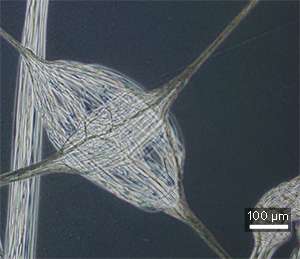Cancer research: Stealth techniques being developed to delay tumor growth

The way in which cancer can spread silently and unnoticed in the body—with symptoms in some cases remaining latent for months, years, or even decades—is often noted as its most deadly feature. Researchers around the world have been devising ever more sophisticated strategies to fight cancer—including 'stealth' techniques designed to outwit the body's immune system so as to deliver therapeutic drugs, genes, proteins and viruses to carefully targeted disease sites. Such approaches may help to turn the tables, enabling researchers to one day realize the ultimate goal of silencing the silent killer.
In a move that reflects the strong, collaborative nature of research at the A*STAR Institute of Bioengineering and Nanotechnology (IBN), a multidisciplinary team of IBN researchers led by Shu Wang, Jackie Y. Ying and Andrew Wan have demonstrated an ingenious stealth-attack method that may help to lead to the more effective elimination of cancer cells. The new method involves coating therapeutic viruses with specially fabricated microfibers composed of peptides and DNA. The microfibers crucially help to 'trick' the body into bringing down its natural defenses. So far, experiments on mice with brain tumors have shown that the microfiber-coated therapeutic viruses can lead to delayed tumor growth and prolonged survival time.
A boost for biomedical research
The new work conducted by Wang and colleagues notably brings together two biomedical innovations developed at IBN. The first is a unique microfiber fabrication technique developed by Andrew Wan and co-workers in 2006. The technique is distinguished by the incorporation of silica into polyelectrolyte-complex fibers, making them highly flexible and suitable as tissue engineering scaffolds. (For more examples of Wan's ongoing work on bioengineering and materials science, see Biomaterials: Fibers in fusion and Bioengineering: Heart-to-heart.)
The second innovation, in turn a result of IBN's extensive experience in investigating engineered insect viruses to treat cancer and neurological disorders, is the successful delivery of therapeutic genes to human embryonic stem cells using a baculoviral vector, achieved by Shu Wang and co-workers in 2006. This study demonstrated the possibility of effective and safe genetic manipulation methods in human embryonic stem cells—an important goal in furthering applications of stem cells in developmental biology and regenerative medicine. Shu Wang has contributed to numerous cancer research studies at IBN, including the successful treatment of mouse brain tumors using genetically engineered insect viruses (see Cancer: Fine-tuning cellular suicide).
The new work builds on the two IBN-developed innovations in order to bring gene therapy—the targeted replacement of disease-causing mutated genes with functional genes—one step closer to clinical reality. To date, the development of synthetic tissue fibers has been limited by the considerable challenges of constructing fibers made up of more than a single type of biomolecular material, such as peptide, protein, RNA or DNA. The team of IBN researchers was able to circumvent this problem by using a water-based procedure that enables the combination of positively-charged peptides and negatively-charged plasmid DNA. The biomolecules effectively combine to form the microfibers and, using the same water-based process, baculoviral vectors can be added to the DNA solution so as to coat therapeutic viruses with the microfibers.
"Experimental work in the area of virus encapsulation thus far has employed polymers and lipids," explains Wang. "There are certain limitations associated with the usage of these synthetic materials. For example, polyesters based on lactic acid and glycolic acid (PLGA) generate acidic degradation products that cause transient tissue inflammation and reduce cell proliferation, and cationic lipids trigger allergic-type immune reactions."
The new method with improved biocompatibility therefore represents a powerful approach to virus-based gene therapies: "For the very first time, we have shown that two biomolecules, namely peptides and DNA, can interact with each other to form structured fibers in a test tube," says Wang. "Since these biomolecules are readily metabolized in the human body to naturally occurring molecules and have no adverse toxicity, they hold strong biomedical potential for the delivery of therapeutic drugs, genes, proteins and viruses to combat cancer."
Prospects for gene therapy
Gene therapy is set to become one of the most important medical treatment strategies of the twenty-first century that may help to lead the fight against many currently incurable diseases such as cancer, AIDS, Parkinson's and Alzheimer's diseases, cystic fibrosis, multiple sclerosis, and diabetes. Advancements that spur progress in effective gene delivery are therefore of key interest to medicinal chemists, pharmaceutical companies, and all those involved in drug design, development and delivery.
"The favorable in vivo application of the virus-containing bio-macromolecule microfibers makes them attractive candidates for localized gene therapy in an environment with complementary components," says Wang. "Fiber encapsulation may also be valuable in minimizing the effects of adaptive immune responses directed against repeated injected gene therapy viral vectors by shielding the encapsulated viruses against neutralizing antibodies. Thus, the results from this study open new avenues for the development of biomolecular material-based drug delivery systems."
Commenting on the remarkable achievements borne out of collaborative efforts at the Institute and the hotly-pursued research area of regenerative medicine, IBN executive director Jackie Y. Ying says, "This innovative application of microfibers with viral vectors is an exciting development for gene therapy that was made possible through multidisciplinary collaboration between biologists, chemists and materials scientists at IBN. Our fibrous materials are also of great interest as biocompatible tissue engineering scaffolds for applications in regenerative medicine."
More information: Yang, J. et al. Microfibers fabricated by non-covalent assembly of peptide and DNA for viral vector encapsulation and cancer therapy. Advanced Materials 24, 3280–3284 (2012). dx.doi.org/10.1002/adma.201201145


















